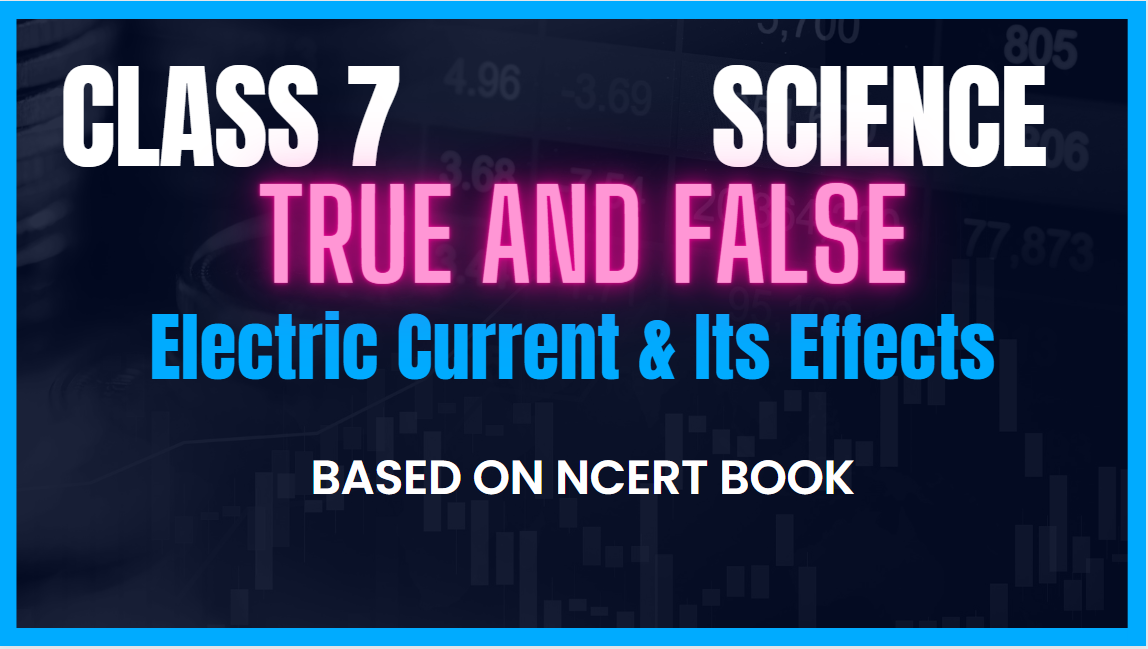1 Electric components can be represented by symbols in circuits.
Answer: True
Explanation: Some common electric components can be represented by symbols in circuits.
2 The longer line in the symbol of an electric cell represents the negative terminal.
Answer: False
Explanation: The longer line in the symbol of an electric cell represents the positive terminal, not the negative terminal.
3 The wires used to connect components in a circuit are represented by symbols.
Answer: False
Explanation: The wires used to connect components in a circuit are represented by lines, not symbols.
4 A battery is a combination of two or more cells.
Answer: True
Explanation: A combination of two or more cells is called a battery.
5 The position of the cells in a battery compartment does not matter as long as they are connected.
Answer: False
Explanation: The positive terminal of one cell should be connected to the negative terminal of the next cell when placing cells in a battery compartment.
6 A circuit diagram is generally used to represent an electric circuit instead of a written explanation.
Answer: True
Explanation: It is much easier to draw a circuit diagram using symbols, and therefore, electric circuits are generally represented by their circuit diagrams.
7 The position of the switch in an electric circuit does not affect the flow of current.
Answer: False
Explanation: When the switch is in the ‘ON’ position, the circuit is complete and the current flows throughout the circuit. When the switch is in the ‘OFF’ position, the circuit is incomplete, and no current flows.
8 It is safe to touch a lighted electric bulb connected to the mains.
Answer: False
Explanation: Touching a lighted electric bulb connected to the mains can be dangerous as it may be very hot and can cause burns.
9 Wires used for making electric circuits normally become hot.
Answer: False
Explanation: Wires used for making electric circuits do not normally become hot.
10 The filament of an electric bulb gets heated to such a high temperature that it starts glowing.
Answer: True
Explanation: The filament of an electric bulb gets heated to a high temperature and starts glowing when the bulb is switched on.
11 Electric fuses are safety devices used to prevent damages to electrical circuits and possible fires.
Answer: True
Explanation: Electric fuses are safety devices used for protecting electrical circuits and preventing potential fire hazards.
12 Fuses are inserted in all electrical circuits to regulate the flow of electric current.
Answer: False
Explanation: Fuses are inserted in electrical circuits to protect against overheating and possible fires, not to regulate the flow of electric current.
13 Steel wool melts and breaks when a large electric current is passed through it.
Answer: False
Explanation: Steel wool does not melt and break when a large electric current is passed through it. Wires made from special materials, not steel wool, melt and break under such conditions.
14 Miniature circuit breakers (MCBs) are used to increase the resistance in electrical circuits.
Answer: False
Explanation: MCBs are used to automatically turn off the circuit when the current exceeds the safe limit, not to increase resistance.
15 Fluorescent tubes and CFLs are considered more electricity efficient lighting sources than incandescent bulbs.
Answer: True
Explanation: According to the passage, fluorescent tubes and CFLs are better electricity efficient lighting sources compared to incandescent bulbs.
16 It is recommended to use electrical appliances and gadgets that carry the ISI mark.
Answer: True
Explanation: Using electrical appliances and gadgets with the ISI mark, which ensures conformity to specified standards.
17 When a bar magnet is brought near the compass needle in Activity 10.5, the needle remains unaffected.
Answer: False
Explanation: When a bar magnet is brought near the compass needle, the needle gets deflected.
18 Hans Christian Oersted noticed the deflection of the compass needle when a bar magnet is brought near it.
Answer: False
Explanation: Hans Christian Oersted noticed the deflection of the compass needle when an electric current flows through a nearby wire.
19 An electric current behaves like a magnet when it flows through a wire without any nearby magnets.
Answer: False
Explanation: An electric current behaves like a magnet when it flows through a wire wrapped around an iron nail.
20 Electromagnets can lift heavy loads because they are made of iron.
Answer: False
Explanation: Electromagnets can lift heavy loads because they can be made very strong, not specifically because they are made of iron.
21 An electric bell consists of an electromagnet and a coil of wire.
Answer: True
Explanation: An electric bell consists of an electromagnet and a coil of wire wound on an iron piece.
22 When the iron strip in an electric bell is in contact with the screw, the bell does not ring.
Answer: False
Explanation: When the iron strip is in contact with the screw, the current flows through the coil, causing the hammer to strike the gong and produce sound.
23 The circuit in an electric bell is repeatedly broken and completed by the electromagnet losing its magnetism.
Answer: True
Explanation: When the electromagnet pulls the iron strip, it breaks the circuit, causing the current to stop flowing. The electromagnet then loses its magnetism, allowing the iron strip to come back in contact with the screw and complete the circuit again.
24 Electromagnets are used to separate magnetic material from junk.
Answer: True
Explanation: Electromagnets are used to separate magnetic material from junk.
25 The heating effect of current is the only application of the magnetic effect of electric current.
Answer: False
Explanation: The magnetic effect of electric current has many applications, including the use of electromagnets and the separation of magnetic material. The heating effect of current is also mentioned separately in the passage.
